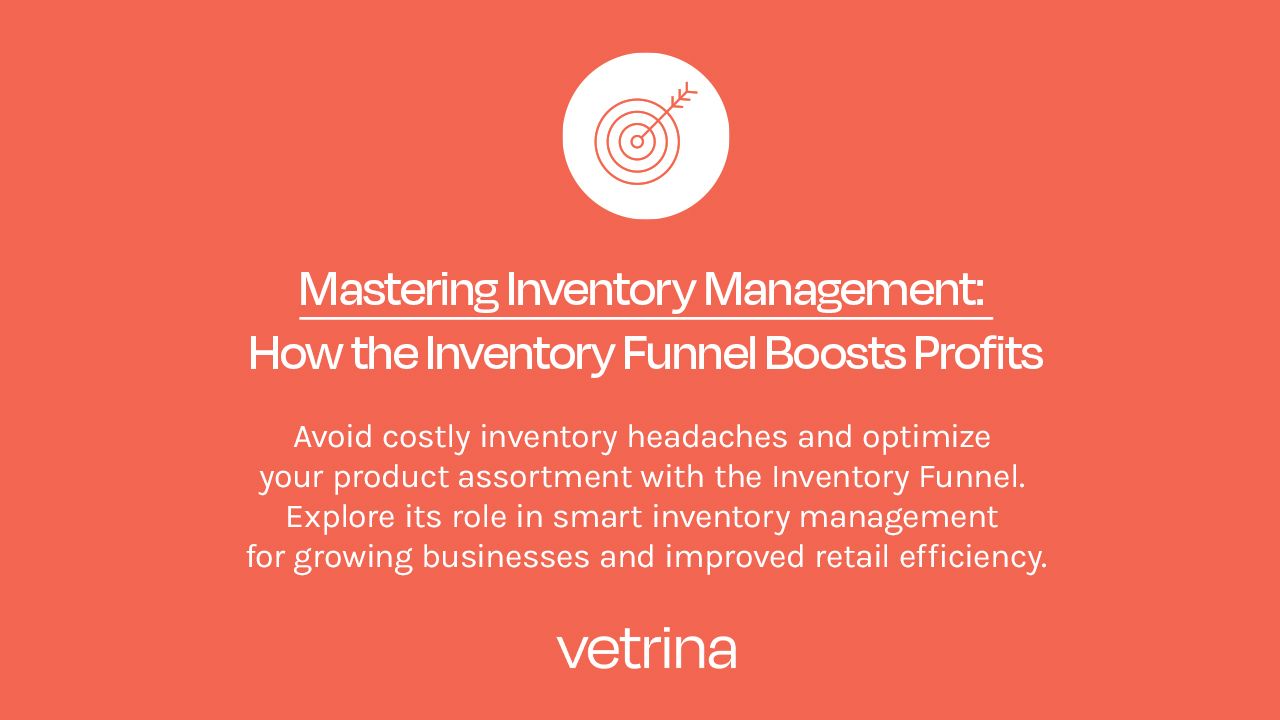
Mastering Inventory Management: How the Inventory Funnel Boosts Profits
Aug 07, 2023Inventory management is a big deal, especially for growing businesses in the cannabis retail world.
You know that frustrating feeling when you try to buy something online, but it's "Out Of Stock"? Or when businesses hold clearance sales due to excess inventory? That can be an indication of poor inventory management.
But how can you avoid these costly headaches and boost profits? You need to know the best way to manage your inventory, that’s where the Inventory Funnel comes in!
In this blog, we’ll break down what it is, why it’s essential, and how it can help your business make smart inventory decisions. We also give clear tactics you can take away and action for both Retailers and Brands.

What is an Inventory Funnel?
At its core, an Inventory Funnel is a decision-making tool that helps retailers and brands determine the right assortment and investment in their inventory. It is designed to narrow down answers through a series of questions, eliminating products that do not meet the criteria. The strategic ordering of these questions ensures that only the most relevant and profitable products make it through the funnel.
Simply put, by using an Inventory Funnel's series of simple questions, you will narrow down your product options and only keep the best ones. You will end up with the right amount of products for your store and your customers.
The Cannabis Retail Inventory Funnel
Let’s look at the key questions that make up the Cannabis Retail Inventory Funnel:
-
Will customers find the product useful?
This question is all about evaluating the potential demand for a particular product. Just because something is new and shiny, doesn't not mean it will have value for your ideal audience. Both retailers and brands can, and should, prioritize products that align with their customer preferences and needs. This means having a clear understanding of who they are, what they value, and may in fact mean making sure you are not only buying or producing products based on your personal preferences.
-
Does the product fit with our store’s vision and mission?
When products align with a store's values and overall objectives, they contribute to a more consistent and appealing shopping experience, reinforcing brand loyalty and attracting like-minded customers. For example, suppose a store's mission is to elevate the cannabis experience to rival that of fine wine. In that case, it would prioritize stocking luxury-feeling products and their corresponding accessories. On the other hand, a brand with a strong focus on environmental responsibility may choose to stock or create products that minimize excessive packaging and prioritize bringing in brands that align with sustainable practices, resonating with environmentally-conscious local clients.
-
Do we already have something similar in stock?
Identifying whether similar products are already in stock helps prevent redundancy and overstocking. By avoiding duplicate products, you can maintain a diverse assortment that caters to various customer needs, ultimately leading to increased sales and optimized inventory management. 🔗 Learn more about reducing choice overload in our blog SKU Rationalization: Maximizing Profitability through Effective Inventory Management
-
What prices are customers willing to pay?
Knowing how much customers are willing to pay for a product is essential for setting the right prices. Retailers and brands can avoid charging too much or too little by understanding customer pricing sensitivity, which leads to increased sales and better profits.
By asking these key questions, you can ensure that you are offering products with genuine demand, aligning with your store’s vision, avoiding redundancies, and setting optimal prices. This strategic approach will lead to a more efficient and customer-centric inventory, enhancing your profitability and setting you apart in the competitive cannabis retail landscape.
What Prices Are Customers Willing to Pay? Understand Pricing Sensitivity.
When it comes to pricing, you want to be strategic and consider the various factors that influence customer behaviour. You should consider factors like customer pricing sensitivity, product velocity, margin dollars, and customers’ perception of value. This will be essential for setting optimal prices that resonate with your target audience and maximize profitability.
Simply put, optimize your prices to:
-
Support velocity = how quickly will the product sell?
Pricing products in a way that supports velocity means finding the sweet spot where customers perceive the product as valuable and are willing to make a purchase promptly. Setting the right price can help increase sales turnover, preventing products from stagnating on the shelves and ensuring a steady flow of new inventory.
-
Customers’ perception of value = what do they think the product is worth?
Perceived value is a significant driver of purchasing decisions. Customers want to feel that they are getting a fair deal for their money. By offering products that meet or exceed customer expectations, you can build trust and loyalty, leading to repeat business and positive word-of-mouth.
-
Margin dollars = your profits
Margin dollars represent the profit you make from each sale after accounting for the cost of goods sold. By carefully evaluating your margins, you can strike a balance between offering competitive prices and ensuring a healthy bottom line.
Inventory Turnover: Understand Success and Opportunities
One metric we teach our clients, and include in our Cannabis Retail Management Course, is how to calculate and use your Inventory Turnover to gauge success and opportunities in your inventory. It is also a handy tool to use while implementing the Inventory Funnel.

Inventory Turnover helps retailers assess inventory efficiency. It tells us how many times a company sells all its inventory within a specific period of time.
A high inventory turnover ratio means efficient management, while a low ratio may suggest slow-moving or excess inventory.
To calculate the inventory turnover ratio ITR), follow this simple formula:
ITR = Units Sold / Average of (Starting units + Ending Units)
or
ITR = Units Sold / ((Starting Units + Ending Units)/2)
For example, let's say you sold 500 prerolls in a year. At the beginning of the year, you had 50 prerolls in your store, and at the end of the year, you had 20 prerolls left. Using the formula:
ITR = 500 / ((50 + 20) / 2)
ITR = 500 / 35 = 14.29
This means you sold all your prerolls approximately 14 times in a year. You can easily see how useful a tool your ITR is when assessing the success of your inventory.
By monitoring your ITR you will over time gain valuable insights into inventory efficiency and begin to make data-backed choices.
Remember, a high ratio means that products are selling rapidly, and you are correctly replenishing them.
While a low ITR suggests slow-selling products and excess inventory. Which could be a result of poor demand forecasting, ineffective inventory control, or an unsuitable product fit.
Multi-store retailer: Tailoring Products to Local Demand
If you are purchasing for multiple locations, or perhaps a national cannabis retail chain with stores across various regions, you likely have realized that you cannot adopt a one-size-fits-all approach to inventory allocation.
By using the Inventory Funnel to analyze the demand patterns and customer preferences unique to each location, you will be able to make data-backed choices that will optimize inventory distribution, reduce the risk of overstocking or stockouts, and ultimately boost sales and the customer experience.
Tactics for Retailers and Brands
Retailers:
- Year-End Review: Take the opportunity to sit down with your merchandising and assortment teams to understand their process and review what’s working and what’s not.
- Diversified Assortment: Optimize your product assortment to cater to customer demands and changes in provincial or state purchasing methods.
- Start Low and Go Slow: When introducing new products, start with a limited quantity to avoid shrinkage.
Brands:
- Share your Product Roadmap: Keep existing partnerships informed about your product roadmap to help them plan for new categories.
- Support New Partnerships: Provide category-specific data to new partners to guide their initial load-ins and prevent inventory shrinkage.
Pricing Compression and Customer Perception
A common mistake made by both retailers and brands is focusing solely on driving prices lower without considering customer needs and preferences. It’s not just about making things cheaper; it’s about finding the right price that makes customers happy.
🔗 Learn more about avoiding the trap of pricing compression in our blog Is Your Discounting Putting You in a Price Compression Trap?
The benefits of good inventory management are enormous. It's like a recipe for success: a seamless customer experience, improved cash flow, maximized profits, reduction in shrinkage/waste, and it will have you standing tall above your competitors.
If reading this has you asking inventory questions and crunching your ITR, be sure to sign up for our newsletter.
Tactical insights to become
a Cannabis Retail Insider!
Access expert insights in one easy-to-digest
and follow-along newsletter.
We hate SPAM. We will never sell your information, for any reason.

